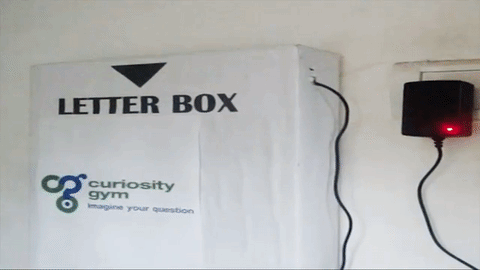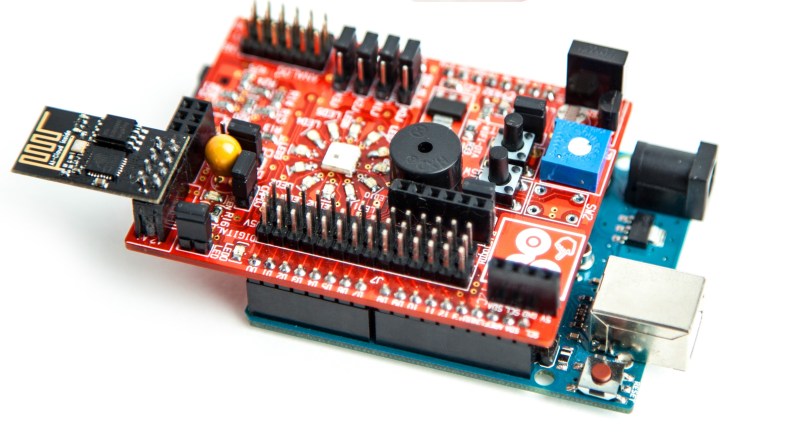If you’re waiting for a much sought-after letter, checking your mailbox every five minutes can be a roller-coaster of emotion — not to mention time-consuming. If you fall into this trap, Hackaday.io user [CuriosityGym] as whipped up a mailbox that will send off an email once the snail-mail arrives.
The project uses an Arduino Uno, an ESP 8266 wifi module, and an idIoTware shield board — making specific use of its RGB LED and light dependent resistor(LDR). Configuring the RGB LED on the idIoTware board to a steady white light sets the baseline for the LDR, and when a letter is dropped in the box, the change in brightness is registered by the LDR, triggering the Arduino to send off the email.
 They used a service called IFTTT — If This Then That — to set up the email process, but feel free to use whatever is most comfortable for you. Be sure to insulate your board properly if you have a metal mailbox! Or, forego the standard letter receptacle and build the smartest mailbox you may ever see.
They used a service called IFTTT — If This Then That — to set up the email process, but feel free to use whatever is most comfortable for you. Be sure to insulate your board properly if you have a metal mailbox! Or, forego the standard letter receptacle and build the smartest mailbox you may ever see.
















Nice post, I’d be interested in this as a bare minimalist approach as I’m
a cheapie hoarder at heart but, well done :-)
I have tried that in here, but never came to finish it. Maybe you can use some ideas >> https://hackaday.io/project/5848-mbas-mail-box-alert-system
https://www.mysensors.org/
Runs for years from a pair of AAA cells, and has gateways to all major home automation systems.
Geesh another site another setup (!) yet more to read more to buy how the fark do
I keep up as my bums getting bigger my heads exploding with so many possibilities
& permutations yikes didnt know about that site but saved gogle time and you guys
drop more links of pitiful old me (?) you guys think I have any neural swapping space left :P
Um, well yes thanks indeed on my list now sigh, nice site :-)
btw:
Re my minimalist approach to this “problem” of mail (& other similar) I have a quiet mail
man, heres something I have the bits for but, got so farkin distracted with more good
sites cyk…
Inside mailbox (which has small hole drilled at back facing house with rain cover);
– thin light plate of pcb material or similar material on bottom of box 1mm from edges
– underneath it on end closest to house delicate weak spring so plate inclined “just enough”
– tiny mirror behind that hole from the inside stuck to end of plate
– IR laser from house shining on mirror from ~ 10m, signal/pulsed ~10 sec @ width 10mS
– gated receiver suitable placed/aimed (interlocked with laser) watching reflection
So when mail turns up in box deflects the mirror just enough to register
loss of signal And if so for several consecutive cycles its something in the
box not a leaf blown across the beam or passing cat tail obscuring signal etc
Also doubles as a indication someone could be coming to the door as in if
back of mailbox coincidentally blocks walking path or trips another beam &
conjunction differentiates between mail in box And visitor. Of course the
IR receiver has a humidty/temp sensor & a little other fruit too…
“…bare minimalist approach…”
*puts fake rat in mailbox*
*waits for audible notification of opened mailbox*
Joking aside, I’ve considered modifying a cheap wireless thermometer so that it has a microswitch and resistor to give a false reading.
Led two at batteries and some wire.
When the post. as put in the postbox it hits the wire completing the circuit. Put the led somewhere visible inside the house.
No wifi telling the whole world you have post.
Alternatively add a flat bedone scanner and control a flap to a shredder,for junk mail.
Just a MSP, a power supply, and a simple switch. you can get rid of 90% of the stuff the guy is using for this
More like 99.9%. I installed a microswitch in my mailbox, and attached it to the “back door” (different tone) terminals on my doorbell. But, hey, that “hack” would just get me laughed at (or ignored) if presented here.
Oooh that looks efficient and widely applicable, not.
I did a similar project but used a different route. I got one of those “driveway minder” motion detector sensors and receiver units for around $11 on sale at Harbor Freight. Put the sensor in the back of the mailbox. Then I hacked into the receiver unit in the house and had an Arduino watch the appropriate pin on the unit’s circuit board that would go high whenever the receiver picked up the RF signal from the sensor (when the mailbox lid was opened). The Arduino had an Ethernet shield wired into a router (set up as a client on our home wifi network) and sent a tweet …. our phones followed that Twitter account. More complicated than it needed to be but it worked (plus I was early in my learning when I did this).
I’m currently in the process of getting rid of the Arduino, Ethernet shield, and WiFi router client and replacing them all with our favorite friend, an ESP8266! Gotta get all this documented on Hackaday.io someday. ????
Would love to see that documentation. As is, or ESP8266 option.
Well with even n=1 encouragement, maybe that can occur over the Christmas holidays. :-)
If you’d like, tweet me your Twitter name to @ArduinoGuy so I know how to get back in touch with you.
I was expecting this to tell you when a SPECIFIC letter arrived… As it stands, it uses a lot of power when it could have easily been a lever switch that wakes a microcontroller to make the call.
A simpler way to do so by [Mike Diamond]
http://www.whatimade.today/esp-8266-mailbox-notifier-using-deepsleep-and-blynk/
Can also do this the economic way
just $4 with a VoCore2
https://www.indiegogo.com/projects/vocore2-4-coin-sized-linux-computer-with-wifi#/
( 7 days left to order)
not order, but invest in the crowndfunding campaign in the hope they deliver to you this cheap gizmo some day in the future.
@tweepy: There is cover for your money, but these guys did deliver the VoCore1 to me before, even though more expensive back then at $20 and drawing more current.
VoCore2 at 74mA is good for price/features, should be called one-inch-linux !
My grandma had a mail alert in the 80’s; a radio with a mercury tilt switch on the mailbox door and base station in the house. You don’t need to draw any power until there is movement/light change in the mailbox, lasts until the batteries leak
This is news? :/
I am quite amused buy the Rube-Goldberg aspect of this build.
Me, I hear the mail truck and that means I might have mail… ;)
so instead of checking the mailbox you are checking your email for the alert. sounds perfectly reasonable.
Complete the cycle!
http://hackaday.com/2009/11/06/physical-email-notification/
I was disappointed when this wasn’t a hack to order a physical postcard be sent to your home address whenever you got an email.
The other day i saw a project to send you an e-mail just using the ESP8266 module http://pdacontrolenglish.blogspot.com.co/2016/07/send-email-with-esp8266-google-docs.html
Everybody has a different skillset and I’m sure this helps some people out. Simple and easy to follow.
Me? I installed pressure plates in the road in front of my mailbox to send an email whenever the mailman drives his jeep over it. The software is calibrated for the exact weight of the vehicle with tolerance for the weight of the driver, mail and variance in fuel in the tank.
Funniest comment to date!!! +1
I actually have something working in my house right now – I got a cheap, $5 wireless doorbell from eBay, wired up a switch to detect when the mailbox was open, wired in an atmega328p to “trigger” the doorbell then send the device into sleep mode (for battery reasons in case the mailbox remains open; I calculate it lasts about 1 year with 3AA batteries). On the receive in my house, I stole the voltage from the LED to power another atmega328, and when the doorbell rings, the atmega flashes the LED until a reset button (added on to the receiver) is pressed. Works quite well; probably 75ft range. Cost me all of $10-15.
We are the creators of the hardware that goes behind this project. We are publishing a project for every day of the campaign.
50 Days of Simplifying Arduino
For every day of this crowdfunding campaign, we’re going to publish a new project showing how the Idiotware Shield simplifies creating awesome Arduino projects. Here we go!
Our campaign is live on crowdsupply https://www.crowdsupply.com/curiosity-gym/idiotware-shield
Thanks for your support and ideas.
Here’s another one, even easier to put together and cheaper..
http://www.abrandao.com/2018/04/arduino_esp32_battery_wifi_door_mailbox_sensor/